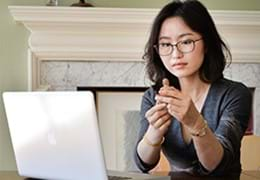An Ode to Joyous Solitude: Veere Grenney at The Temple | Wednesday 3 September 2025
Veere Grenney has been at the forefront of the international interior design industry for over 30 years. We are proud to present his personal collection in our auction Veere Grenney at the Temple, taking place on Wednesday 3 September.
Nestled within rolling parkland lies The Temple: an eighteenth-century Palladian folly reimagined - and ultimately claimed as home by Grenney over the past four decades. First glimpsed as a derelict jewel by a teenage Grenney in a David Hicks monograph, the building's grace and promise ignited a lifelong devotion. In 1985, after stints at Colefax & Fowler, he took on the lease and began a transformation as quiet and meticulous as it was profound.
Here, Veere Grenney tells us more about his beloved Suffolk home and the collection that he has spent a lifetime building.

An Ode to Joyous Solitude by Veere Grenney
The Temple. What could be more evocative as the name of a house? My Palladian folly in the Suffolk country is a monument to Georgian proportion, to the four seasons and to the pastoral landscape it occupies in a patch of England immortalised by John Constable in the early 1800’s.
Memorably described as ‘Palace above and cottage below’, it was built in the 1750s by Sir Robert Taylor. He designed it as a ‘fishing temple’ situated on the estate of Tendring Hall, so that guests could wander down here from the big house to fish and stroll along the broad artificial canal that stretches two-hundred yards from the arched loggia of the villa itself. It fell into dereliction but was rescued in the early 1960s by David Hicks, and taken up by me in the 1980’s. The place delivers all those traditional cornerstones of the English country house, the grandest of drawing rooms and most inviting of bedrooms, the pristine lawns and pleached limes, a cutting garden dense with dahlias, borders thick with roses and glasshouses crammed with pelargoniums. And then, added in, are those touches of old American glamour, of my New Zealand past; the white metal lattice chairs originally owned by Bunny Mellon, the portfolio of ferns hung on the staircase from New Zealand, 1904.

The Temple has allowed me to escape from London and belong to the English countryside. It expresses my complete journey as a designer, linking my childhood in New Zealand to my life in London and Tangier. It connects me to one of my earliest influences – David Hicks – and was one of my first encounters with classical beauty. I was still at school in Auckland when, reading a book about Hicks, I came across an image of The Temple. Many years and many homes later, in 1985, I visited the place as a guest of antiques dealer Charles Beresford Clark and fell instantly in love. It was and is, aesthetic perfection, a single exquisite space, one room deep, sat theatrically in bucolic countryside. I sold my London flat and took on the lease. That was 1985 and it has remained the house I have come to in all seasons for reflection and retreat. While not a literal place of worship, it has always been a sacred space for me, affording me the opportunity for pause, reflection.

The heart of The Temple is the saloon or piano nobile with its twin, enormous, Georgian windows facing east and west. Four busts of Roman emperors preside, two at each end, representing the four ages of man. The plasterwork on the ceiling – restored twenty years ago - depicts the four seasons through the four faces of summer, winter, autumn, and spring. The room was painted Temple Pink in 2002. I was inspired by Nancy Lancaster’s legendary Potted Shrimp and mixed my own shade with her niece Elizabeth Winn. The tulipieres atop the mantelpiece are from Christian Dior in the 1950’s. Furniture upholstered in my own fabric sits side by side with 19th century antiques. The chandelier is 19th/20th century and has been here for 30 years. I always have giant standard geraniums that fill the alcoves.

The room sits at the meeting point of two landscapes, to one side the rolling arable land of Suffolk and to the other the canal. Destroyed by the great storm in 1987, I planted twenty-five lime trees along each side. Traditionally, Palladian villas never had great formal gardens and what you can see here is simply yew and hornbeam. The rose garden, dahlia beds and glasshouse hidden so that they do not interrupt the pastoral ideal.

Like everything, The Temple been entirely personal and has been a long chapter in my life. It has welcomed friends and family, provided me with stillness and escape. And while I am now letting go, that perfect marriage of charm and classicism, the ideal proportions and ineffable grace of the place will stay with me. The contents here express my narrative as a designer, they have afforded me joy and they speak of this beautiful anomaly they come from, a tiny pavilion, the grandest of spaces, a rural retreat and – for a while – my home.

View page turning catalogue
Auction Details
Auction:
Wednesday 3 September 2025 | 2pm BST
Dreweatts, Donnington Priory, Newbury, Berkshire RG14 2JE, UK
Bidding is available in person at our salerooms, online, by telephone or you can leave commission (absentee) bids.
Browse the auction
Sign up to email alerts
Viewing:
Dreweatts London: 16-17 Pall Mall, SW1Y 5LU, UK
- Friday 29 August: 10am - 4pm
- Monday 1 September: 10am - 4pm
- Tuesday: 2 September: 10am - 4pm
Dreweatts Remote Viewing Service | Available from Friday 29 August
Further information:
General enquiries: + 44 (0) 1635 553 553 | housesales@dreweatts.com
Press enquiries: press@dreweatts.com

















